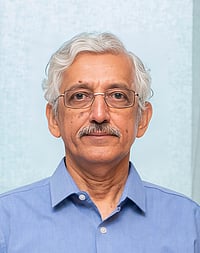Hanumavva was all of 15 when she began picking rags from the back alleys of Mangaluru’s Kana neighbourhood. Now, she is 42. Over the years she saw the world around her change—its skyline taken over by gleaming towers built to house the city’s booming pharmaceutical and IT businesses and their executives.
There is so much more plastic now: discarded cans, phones, bags, food wrappers, takeaway containers, even the odd-remote control…
But nothing had changed in her life until the day she became part of Plastics for Change, a Bengaluru-based social enterprise that helps waste pickers like Hanumavva rebuild their lives.
“Now, I have a scrap shop of my own, and I earn Rs 30,000–35,000 a month,” says Hanumavva. She is also now entitled to basic employee benefits, including health and safety covers. “I have bought a vehicle, and the company is helping me with getting a driving licence,” she says.
Urban India generates 62mn tonne of trash annually. This includes 5.6mn tonne of plastic waste of which only 8% is recycled. On the frontlines of India’s daily battle with mounting waste, there is an estimated 1.5mn-strong army of rag-pickers.
A report from Hasiru Dala, a Bengaluru-based organisation working to secure the dignity and livelihoods of waste pickers, suggests that the city’s municipality saves Rs 84 crore annually in collection and transportation costs thanks to their toil. Yet, their work is seldom even noticed, let alone recognised.
“The most vulnerable of migrant workers come to cities searching for work end up in waste collection,” says Shifrah Jacobs, co-founder and chief impact officer of Plastics for Change.
Lending a Helping Hand
Over the years, several urban local bodies and NGOs have tried to mainstream the workers. The Indian Pollution Control Association (IPCA), for example, has built a nationwide network of 30,000-plus workers, who regularly participate in workshops to improve their hygiene awareness and grasp of market dynamics. “Understanding what kind of plastic fetches what price helps workers make better choices on the ground,” says Ashish Jain, director of IPCA.
These efforts are paying off. Workers who earlier earned Rs 8,000–10,000 a month are reporting incomes of up to Rs 25,000–30,000 post-training, with many finding steady work at material recovery facilities.
However, the pace of formalisation is uneven. For example, PET bottles are widely collected in the National Capital Region because of the proximity of recycling plants but are cast away in places like Jammu or Ladakh because the cost of transporting them to faraway processing units is prohibitive. Similarly, glass is actively recycled in Punjab and Haryana but discarded elsewhere.
For formalisation to scale and succeed, waste workers need access to better tools, improved mobility and handling centres. With India’s plastic waste projected to grow tenfold by 2030—with leakage into the environment expected to reach 40mn tonne—the imperative to support and empower them has never been more compelling.
For years, NGOs have led efforts to draw the workers into the formal fold. SWaCH, a Pune-based cooperative of independent waste pickers, employs more than 3,600 waste pickers, 70% of them women, to turn 300 tonne of discarded material into wealth annually.
Hasiru Dala trains them to become self-employed waste collectors who offer door-to-door services. It supports 37 dry waste collection centres across the city, run by waste pickers and self-help groups. Similarly, Delhi-based Chintan supports Safai Sena, an army of waste recyclers. Safai Sena is a registered association of over 12,000 waste pickers across three states in North India.
After onboarding over 10,000 waste pickers and 260 kabadiwallahs on its platform, Plastics for Change is now working with scrap shop owners, helping them adopt standardised safety and design protocols, including floor layout planning for proper segregation. It also ensures that waste pickers get a fair price for their offerings from kabadiwallahs on its platform. The larger goal is to help these enterprises qualify for MSME registration and transition into the formal economy.
“We train them on essentials like managing cash flows, getting a small lease, sales, management and finance,” says Jacobs of Plastics for Change. “The income of some of them has gone up from Rs 6,000 to Rs 50,000.”
Giving a Leg Up
Apart from the NGOs, several waste-management companies and start-ups too have recognised the importance of informal waste pickers and their enormous experience. ScrapUncle claims to be an online kabadiwallah. Before starting out, its founder, Mukul Chhabra, spent time with traditional kabadiwallahs, understanding the trade. Later, he onboarded them into the system of waste collection he created.
“Now, some of them work as supervisors and managers, earning Rs 40,000–60,000 a month,” Chhabra says. The company hires traditional kabadiwallahs and other informal workers who are interested and pays them Rs 30,000–40,000 a month based on their performance.
Other prominent entities in the space, including recyclers like Go Rewise and Econscious. Yash Sharma, director of Go Rewise, says, “We work with aggregators who buy PET plastic waste bottles from kabadiwallahs and waste pickers and compress them into bales.”
Some brands, too, have begun engaging in ethical sourcing practices. For instance, The Body Shop sourced recycled plastic collected by waste pickers from multiple locations across the country.
For the country to meet its commitments under the Plastics Pact, it will need to recycle 50% of all plastic used in packaging and reuse 25% of that in packaging by 2030—targets that simply cannot be achieved without the active involvement of the informal waste-collection community.


































